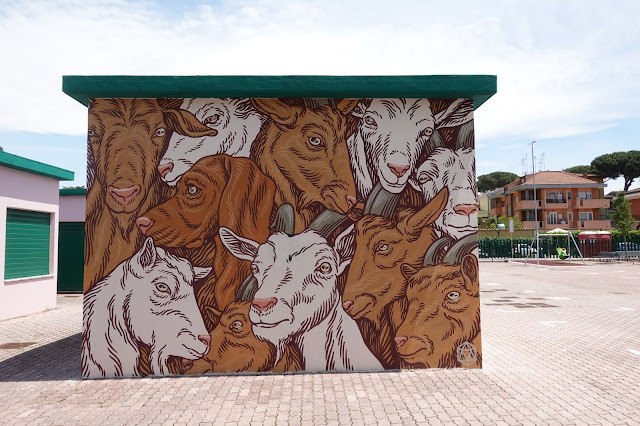We've been drawn to and appalled by Corviale, the massive, kilometer long, 1970s housing project in the south of Rome, since we first saw the place more than a decade ago. It's still there, and it's still intimidating, especially for those who, like us, obviously don't live there and don't "belong." We're voyeurs, and we know it. On the sunny early June day we visited, we were once again in awe of the sheer size of the complex, as well as its sameness; we were once again taken aback at the exterior corridors that seemed to stretch into infinity; and we were surprised at how few people we saw--Corviale seemed empty.
If that were all there was to this world-famous housing project, we would be repeating ourselves and risking boring our readers. There's another side to today's Corviale: it's become one of Rome's premier sites for high-level wall art.
After parking the scooter in a near-vacant parking lot, we walked over to the structure. This is the first thing we saw:
Turning right, there's this work by the artist SFHIR, a minor piece but interesting for its message, as if all of Corviale's street art had been done illegally, under cover of darkness. We doubt it. There's too much art here, and much of it too large and complex, to have been completed without knowledge--and permission--of the authorities.
We found the mermaid below, the first of several works that combine wall art with poetry. We asked our Roman friend MV, a professional translator, to help us with the words, and we're glad we did, because almost every line is difficult.
Here's what MV came up with, starting from the top:
Open your shutters [serrande] there's something great to [see]
It stirs your mind, but not your senses/snake [the rhyme is mente (mind) serpente (serpent, or snake, a reference to Corviale, whose nickname is The Serpent)]
It welcomes you in her arms [or breasts [seno], or lap]
The 'hood' [periferia] is a state of [my] mind [MV adds, of course here the pun works much better in English; it's obviously referring to the mental clinic next door]
People pierced by splinters [schegge, misspelled here; MV adds that the word schegge is usually associated with wood, but the word trafitto is usually associated with spines/thorns]
It's been a prison [or, it is a prison state, or if the mermaid's tail covers the word "in," it could be "it did time in prison"]
Mille Grazie, MV!
And another with a message: "If you have no memory, you have no knowledge." More snakes--again, reflecting Corviale's nickname, "serpentone" (big snake).
Some of the art is clustered in and around a small stadium (which we missed on our first trip), including a whimsical tableaux by LAC 68, one of our favorite street artists. His "signature" is a white figure with a shopping cart (far right side).
LAC 68 also did this portrait of a woman. "Pupo" translates as kid; "geloso" as jealous. Looks like she's stroking a cat-like creature.
It was one of a number of depictions of women:
Including several by Pier the Rain, an artist unfamiliar to us:
On the level below the stadium, where there is a functioning business or two, we found the lovely "Corviale" mural that for the past few months has served as the cover photo for our
romethesecondtime Facebook site:
And this piece, with some serious word content, perhaps referring to life at Corviale:
Our reality is tragic,
but it's only one fourth:
The rest is comedy.
One can laugh
at almost everything.
On the level above, the artist QWERTY has fashioned one of his well-known, playful--but also deadly serious--stick figures (left side). Shades of
Guernica?
And a painted walkway.
With a police station close by:
Aside from the wall art, and while exploring Corviale and near-environs, we found a few objects of interest. One of them was a old rusted sign for an alimentari (a small foods store), an indication of what used to be and isn't any more. As far as we know, there is no commerce in or near Corviale.
And across the street from Corviale proper, we saw what appeared to be an abandoned social space:
Just beyond it, a short tunnel with words by Pier Paolo Pasolini, the Roman poet, novelist and film-maker known to have visited the city's public housing projects--though not this one. He was murdered in 1975, the year construction of Corviale began.
"Beauty can pass through the strangest streets."
Within a stone's throw, an upscale sports facility, likely not intended for the mostly downscale residents of Corviale, though the complex also harbors some wealthier folks.
Corviale has a small, comfortable library:
As well as a modern art gallery!
And now, its own worthy collection of outdoor public art.
Bill
 Rome's winters are often cold and rainy. But now and then the rain turns to snow. The kids love it, and the adults find the camera and take pictures before the melting begins, often in minutes. It happened on February 12, 2010, and our friend Massimo found the camera and took these shots from the windows of his apartment near Piazza Bologna. That's our beloved Malaguti (below, since replaced by a Honda Forza 300), right next to the sideways-parked Smart car, covered in the white stuff. Looks like Christmas--soooo, Merry Christmas and Happy Holidays!
Rome's winters are often cold and rainy. But now and then the rain turns to snow. The kids love it, and the adults find the camera and take pictures before the melting begins, often in minutes. It happened on February 12, 2010, and our friend Massimo found the camera and took these shots from the windows of his apartment near Piazza Bologna. That's our beloved Malaguti (below, since replaced by a Honda Forza 300), right next to the sideways-parked Smart car, covered in the white stuff. Looks like Christmas--soooo, Merry Christmas and Happy Holidays!




